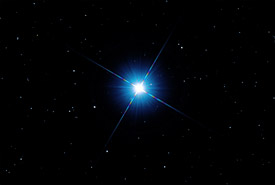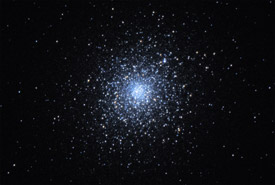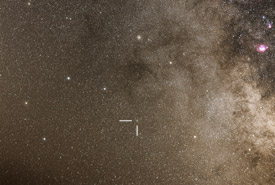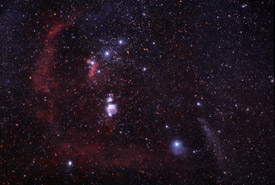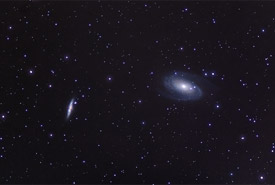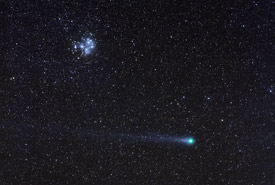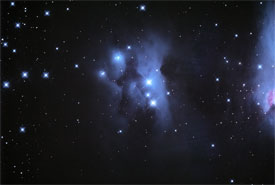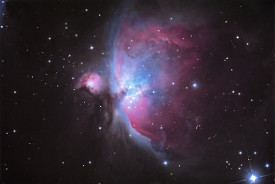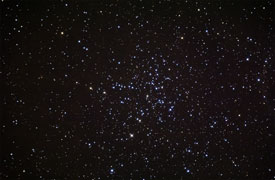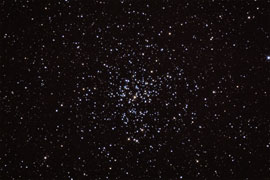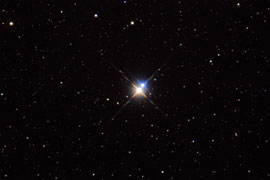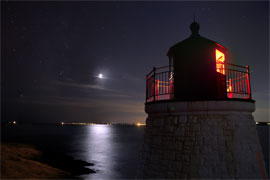
Recent
Vega, Beautifully Blue
I often overlook many of the common stars visible in the night sky. Though in taking these stars for granted, I miss out on a chance to capture how beautiful they actually are. This is Vega, the fifth brightest star in Earth's sky. 25 light years distant and 2x the mass of the Sun, Vega is stunningly beautiful. I snapped this at Frosty Drew Observatory in Charlestown, Rhode Island, USA.
- By: Scott MacNeill
The Milky Way Returns to Frosty Drew Observatory on Earth Day
While watching the 2015 Lyrid Meteor Shower and attempting to capture a few passing meteors I noticed a significant amount of Airglow among the rather thick haze. As the stunning Milky Way rose higher off the horizon my camera started picking up fascinating colors in the haze. Awesome night! I snapped this at Frosty Drew Observatory in Charlestown, Rhode Island, USA.
- By: Scott MacNeill
Messier 5: A Huge Globular Cluster
Messier 5 is one of the larger known globular clusters in the Milky Way galaxy. A spring and summertime object, Messier 5 is found in the constellation Serpens. I snapped this photo at Frosty Drew Observatory in Charlestown, Rhode Island, USA.
- By: Scott MacNeill
Antares and the Rho Ophiuchus Cloud Complex
As spring moves into New England, so do fabulous views of the bright Milky Way. One morning while waiting for Nova Sagittarius 2015 to rise, I noticed Antares hanging just perfectly in the southern starscape and couldn't pass up the change to capture this shot. I snapped this at Frosty Drew Observatory in Charlestown, Rhode Island, USA.
- By: Scott MacNeill
Nova Sagittarius 2015 No. 2
On March 15, 2015 a bright Nova became apparent in the constellation Sagittarius. The Nova quickly brightened to magnitude 4.4 by March 21, 2015 and then sharply decreased. I snapped this shot of the Nova on the morning of March 23, 2015 just before pre-dawn at Frosty Drew Observatory in Charlestown, Rhode Island, USA.
- By: Scott MacNeill
Venus, Mars, and the 4% Crescent Moon: A Dance
On Friday February 20, 2015 the stunning 4% Crescent Moon joined in a fabulous celestial dance with Venus and Mars just above the Western horizon in one of the more breathtaking conjunctions of the year. I snapped this shot during astronomical twilight at Frosty Drew Observatory in Charlestown, Rhode Island, USA.
- By: Scott MacNeill
The Orion Molecular Cloud Complex
A stunning shot of the Orion Molecular Cloud Complex I snapped on Friday, February 13, 2015 at Frosty Drew Observatory in Charlestown, Rhode Island, USA. The Complex is made up of the M42 (Orion Nebula), M43 (de Mairan's Nebula), NGC 1975 (Running Man), NGC 2024 (Flame Nebula), IC 434 (Horsehead Nebula), M78, IC 2118 (Witches Head Nebula), Barnard's Loop, and more.
- By: Scott MacNeill
Bode's Galaxies: A Celestial Pairing
A subtle image I captured of Bode's Galaxies (M81 & M82) on Saturday, January 17, 2015 from Frosty Drew Observatory in Charlestown, Rhode Island, USA. Messier 82 (The Cigar Galaxy) is at the left with Messier 81 at the right. M82 hosted the fabulous supernova SN 2014j in January 2014. I shot this after an excellent session with Comet C/2014 Q2 Lovejoy!
- By: Scott MacNeill
Comet C/2014 Q2 Lovejoy and Seven Sisters
A stunning photo I captured of Comet C/2014 Q2 Lovejoy just West of the Pleiades Open Star Cluster (Messier 45). I captured this view on Friday, January 16, 2015 at Frosty Drew Observatory in Charlestown, Rhode Island, USA. Comet Lovejoy has been a fabulous comet and is lighting up the starscape for sky watchers everywhere!
- By: Scott MacNeill
NGC 1977 Running Across Orion
The late November 2014 starscape at Frosty Drew is fantastic. The excellent collection of Winter objects become quite visible and cooler temps make for bug free shooting sessions. This is a shot of NGC 1977: The Running Man Nebula. NGC 1977 is a reflection nebula that resides in the constellation Orion and lies 1,500 light years distant. The Running Man is part of the larger Orion Molecular Cloud Complex.
- By: Scott MacNeill
Messier 42: The Orion Nebula
As we welcome the arrival of Winter we also welcome the return of the most fascinating nebula, Messier 42 - The Orion Nebula. Naked eye visible as the center star in Orion's sword, the Orion Nebula lies 1,500 light years distant making it the closest star forming region to Earth.
- By: Scott MacNeill
Messier 38: The Starfish Cluster
While relaxing under the fabulous starscape of Charlestown, Rhode Island, I captured this view of the M38 open star cluster. Messier 38 resides in the constellation Auriga and lies 4,200 light years distant, spanning about 25 light years in diameter.
- By: Scott MacNeill
Messier 37: An Open Star Cluster in Auriga
Messier 37 (M37) is a dense open star cluster in the constellation Auriga. I captured this shot under clear skies at Frosty Drew Observatory in Charlestown, Rhode Island, USA.
- By: Scott MacNeill
Albireo, A Rather Famous Binary Star
Albireo is one of the most viewed binary stars in the night sky. Residing in the constellation Cygnus, Albireo is 384 light years distant from Earth. I captured this shot on a super clear night at Frosty Drew Observatory in Charlestown, Rhode Island, USA.
- By: Scott MacNeill
Castle Hill Light with Crescent Moon
While waiting for the ORB-3 launch that catastrophically ended in failure, I snapped this photo of the Castle Hill light house with the Crescent Moon setting over the bay in Newport, Rhode Island, USA.
- By: Scott MacNeill
